The Fascinating Legacy of Tsubaki Oil for Hair
For centuries, tsubaki oil has been a cornerstone of Japanese beauty rituals, especially hair care. Derived from the seeds of the Camellia japonica plant, it wasn't simply a cosmetic; it was essential for achieving the elaborate hairstyles of geishas and maintaining the healthy hair of samurai warriors. Intrigued? You might enjoy exploring more Japanese beauty products. This rich history speaks to tsubaki oil's enduring benefits.
Tsubaki oil's prominence in Japanese culture stems from its unique properties. Also known as camellia oil, it boasts a history spanning over 1,000 years in Japan. Traditionally, it was used to promote smooth, shiny, and healthy scalps. Geishas and samurai warriors alike relied on tsubaki oil to keep their hair strong and lustrous.
The oil's primary component is oleic acid (around 80-85%), a monounsaturated fatty acid remarkably similar to the scalp's natural oils. This makes it exceptionally effective for moisturizing and protecting hair. Furthermore, tsubaki oil contains antioxidants like vitamin E and polyphenols, shielding hair from environmental damage and premature aging. This historical usage cemented its place as a vital beauty and health product, influencing modern cosmetic formulations globally. Discover more insights about tsubaki oil's history.
From Ancient Rituals to Modern Applications
The extraction of tsubaki oil has also seen significant changes. Traditionally, the oil was meticulously hand-pressed, prioritizing purity and quality. This careful process ensured the oil retained its beneficial properties.
Today, while some artisans maintain these traditional practices, modern cold-pressing techniques are more prevalent. These methods preserve the oil's integrity while enabling larger-scale production.
Why Tradition Matters
Understanding the history of tsubaki oil offers more than just a glimpse into the past. This cultural context underscores its lasting effectiveness, showcasing results that synthetic alternatives often struggle to replicate.
It explains why tsubaki oil remains a sought-after ingredient, prized for its natural ability to nourish and improve hair health. This legacy of proven efficacy resonates with those seeking natural and effective hair care.
The Science Behind Tsubaki Oil's Power
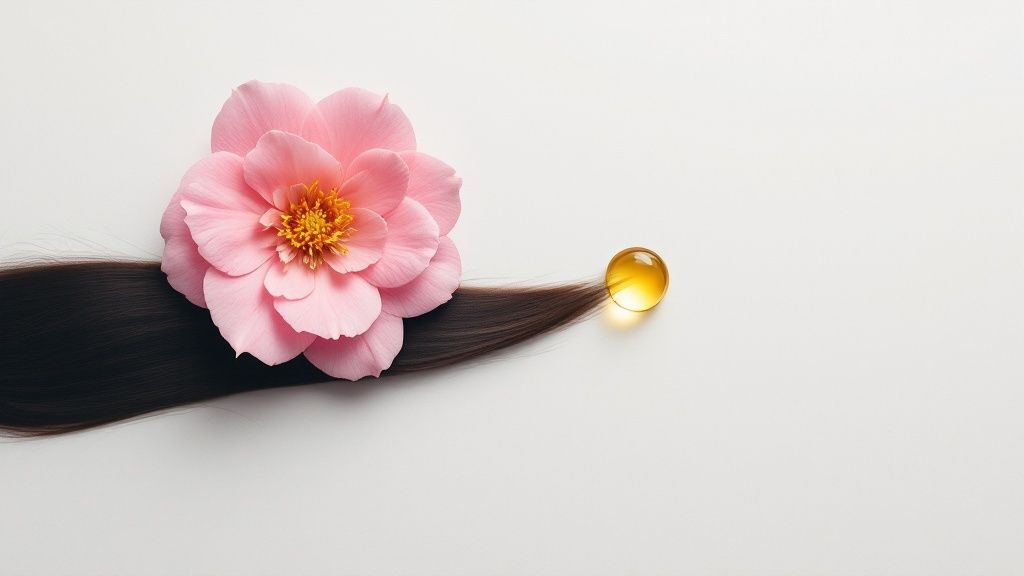
Tsubaki oil, prized for its beautifying properties, is more than just a popular ingredient. Its effectiveness is grounded in scientific principles. The oil's unique molecular structure works with your hair's natural environment, unlike some products that can disrupt this delicate balance. This synergy is the key to understanding its benefits.
Mimicking Nature's Design: The Fatty Acid Profile
One of the most important aspects of tsubaki oil is its fatty acid composition. It's especially rich in oleic acid, a monounsaturated fatty acid similar to the sebum naturally produced by your scalp. This similarity allows for easy absorption and effective moisturizing without a greasy feel. Tsubaki oil replenishes and protects your hair by mimicking its natural oils.
Tsubaki oil also contains other essential fatty acids like linoleic acid and alpha-linolenic acid, which contribute to its nourishing and strengthening properties. These acids help maintain the hair cuticle, preventing breakage and split ends. Learn more in this article about Japanese beauty products.
The Antioxidant Shield: Protection Against Environmental Stressors
In addition to its fatty acid profile, tsubaki oil has a strong antioxidant capacity. It contains vitamin E, polyphenols, and flavonoids, which protect hair from environmental damage. These antioxidants neutralize free radicals, which can harm hair proteins and lead to dullness, breakage, and premature aging. This protective shield maintains hair health, especially in harsh conditions.
The Ideal Molecular Weight: Deep Penetration Without the Weight
The molecular weight of tsubaki oil is another key factor in its efficacy. It's the "Goldilocks" of hair oils – not too heavy, not too light. This allows it to penetrate the hair shaft effectively. This deep penetration nourishes and strengthens hair from the inside, rather than just coating the surface.
Unlike heavier oils, tsubaki oil won't weigh hair down, leaving it light and manageable. This balance makes it suitable for a variety of hair types.
Superior Absorption: The Research
Studies comparing tsubaki oil to other popular oils have demonstrated its superior absorption rate. This enhanced absorption helps deliver nutrients and moisture quickly to the hair cortex. This rapid, deep absorption leads to visible improvements in hair health and appearance, often exceeding the benefits of other oils. This makes tsubaki oil a highly effective choice for hair care.
7 Game-Changing Benefits of Tsubaki Oil for Your Hair
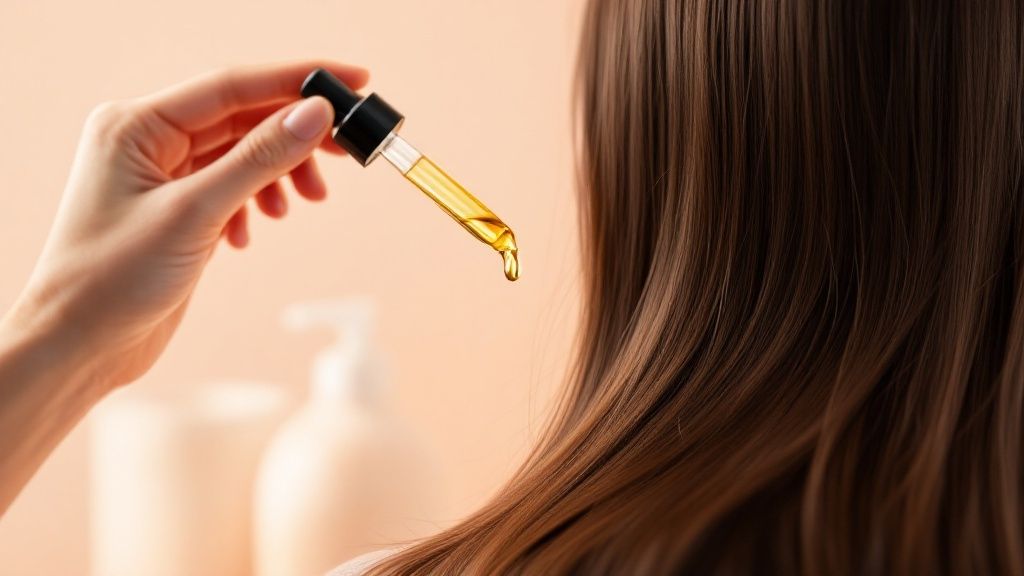
Tsubaki oil, a cornerstone of Japanese beauty traditions, offers a wealth of benefits for healthy hair. More than just a superficial fix, this oil nourishes from within, transforming your hair's health and appearance. Let's explore the remarkable ways tsubaki oil can elevate your hair care routine.
Enhanced Shine and Luster
Tsubaki oil imparts a stunning sheen, making hair appear vibrant and healthy. The oil's unique structure smooths the hair cuticle, allowing light to reflect more effectively. This results in a noticeable boost in shine and overall luster.
Deep Hydration and Moisture Retention
Say goodbye to dry, brittle hair with tsubaki oil. Its rich oleic acid content closely resembles the scalp's natural oils, enabling deep penetration and long-lasting hydration. This helps combat dryness and keeps hair moisturized for extended periods.
Reduced Breakage and Split Ends
Tsubaki oil strengthens the hair shaft, significantly minimizing breakage and split ends. This is essential for maintaining length and encouraging healthy growth, especially for those who frequently use heat styling tools or chemical treatments.
Improved Scalp Health
A healthy scalp is the foundation for healthy hair. Tsubaki oil helps balance the scalp's natural environment, reducing dryness, itchiness, and dandruff. This creates the ideal conditions for strong, healthy hair growth.
Protection From Environmental Damage
Tsubaki oil forms a protective barrier against environmental stressors such as UV radiation and pollution. This shields hair from damage, preserving its health and color vibrancy. For instance, it can help prevent color fading in color-treated hair. Understanding the nuances between different oils is important. Learn more about the differences between various oils here: Hemp Oil Vs Cbd Oil Vs Marijuana.
Enhanced Manageability and Reduced Frizz
Tsubaki oil smooths the hair cuticle, reducing frizz and making hair more manageable. This is particularly beneficial for those with coarse or unruly hair, simplifying styling and minimizing tangles.
Faster Hair Growth
While tsubaki oil doesn't directly stimulate new hair growth, it fosters a healthier scalp and reduces breakage. This creates an environment conducive to growth, leading to improvements in length and thickness over time. Interested in other Japanese beauty products? Explore a wider selection here.
To further illustrate the advantages of tsubaki oil, let's compare it to other popular hair oils. The table below highlights key similarities and differences in their benefits.
Tsubaki Oil Benefits Comparison
| Benefit | Tsubaki Oil | Argan Oil | Coconut Oil | Jojoba Oil |
|---|---|---|---|---|
| Shine & Luster | Excellent | Excellent | Good | Moderate |
| Hydration | Excellent | Excellent | Good | Good |
| Breakage Reduction | Excellent | Good | Moderate | Moderate |
| Scalp Health | Excellent | Good | Good | Excellent |
| UV Protection | Good | Good | Moderate | Moderate |
| Frizz Reduction | Excellent | Excellent | Moderate | Moderate |
| Manageability | Excellent | Excellent | Good | Good |
As you can see, tsubaki oil offers a comprehensive range of benefits for hair care, rivaling and often surpassing other popular oils in key areas like shine, hydration, and breakage reduction. Its ability to improve both hair and scalp health makes it a truly valuable addition to any hair care routine.
Mastering Tsubaki Oil Application Techniques
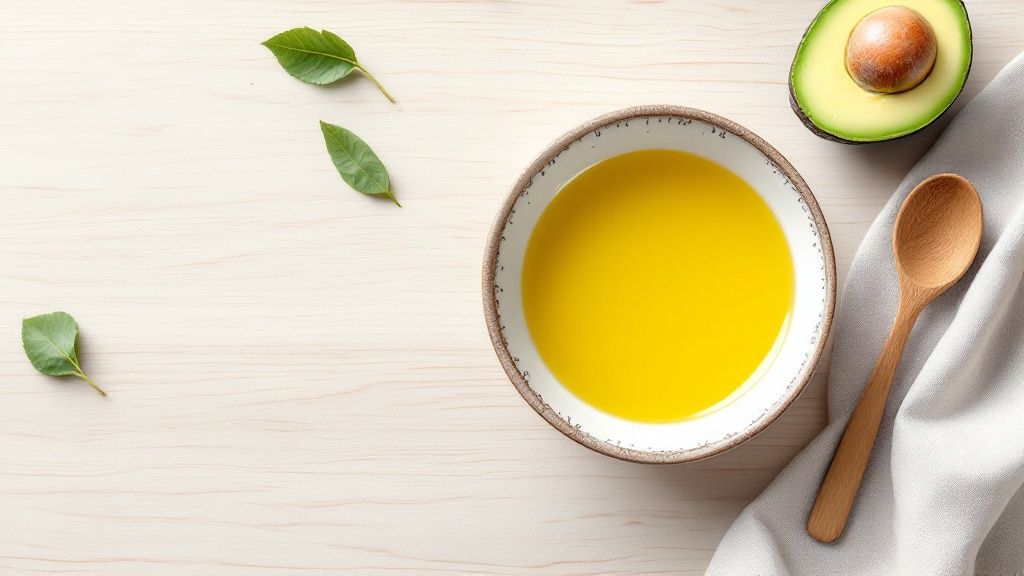
Want to elevate your hair care game? Learn the secrets of using tsubaki oil effectively. These techniques, often used by professional stylists, offer practical and effective methods for various hair care needs. We'll explore five different tsubaki oil treatments, from quick pre-shower rituals to luxurious overnight deep conditioning.
Pre-Shower Scalp Massage: A 3-Minute Treat
This quick treatment involves massaging a small amount of tsubaki oil into your scalp before hopping in the shower. If you have short hair, 2-3 drops should be enough. For longer, thicker hair, you can increase the amount gradually up to a maximum of 6-8 drops. Warm the oil slightly between your palms to help it absorb better. Gently massage the oil into your scalp using circular motions for 3 minutes, concentrating on any dry or problem areas. This boosts circulation and preps your scalp for shampooing, giving your hair a healthy shine.
Overnight Intensive Repair Mask: Deep Conditioning for Damaged Hair
This treatment is perfect for dry, damaged hair needing some serious TLC. Apply a bit more tsubaki oil than you would for a scalp massage, working it through your hair from mid-length to the ends. A wide-tooth comb can help distribute the oil evenly. Wrap your hair in a soft towel or shower cap to protect your pillowcase. Wash your hair thoroughly in the morning to reveal noticeably softer, repaired hair.
Post-Shower Shine Booster: Taming Frizz and Adding Luster
After showering, towel-dry your hair and apply a small amount of tsubaki oil, focusing on the ends and any frizzy areas. 1-2 drops usually suffice for fine hair, while thicker hair might need 3-4 drops. This simple step adds shine, tames frizz, and even provides a layer of protection against heat styling. It's the perfect finishing touch for smooth, manageable hair.
Pre-Styling Heat Protectant: Shielding Hair From Damage
Before using heat styling tools like straighteners or curling irons, apply a few drops of tsubaki oil to your hair, whether it's damp or dry. This creates a protective barrier, shielding your hair from heat damage. It's a must-have for anyone who regularly heat styles.
Weekly Scalp Treatment: Promoting Healthy Growth
Once a week, treat yourself to a 10-15 minute intensive scalp massage. Use 4-6 drops of warmed tsubaki oil (adjusting the amount based on your hair thickness). Massage deeply into your scalp to stimulate circulation and nourish those hair follicles. This promotes a healthy scalp environment, potentially improving hair growth. Leave the oil on for at least 30 minutes before shampooing for long-term scalp and hair health.
Timing and Layering: Optimizing Your Tsubaki Oil Routine
When you apply tsubaki oil can make a big difference. Applying it to damp hair improves absorption, while using it on dry hair provides immediate shine and frizz control. Tsubaki oil can also be layered with other hair products. Start with small amounts to avoid build-up, and experiment to find what works best for you.
Troubleshooting: Addressing Common Concerns
Using too much tsubaki oil can sometimes lead to greasy hair. If this happens, use a clarifying shampoo to remove the excess oil. You might also need to adjust the amount of oil you use depending on your hair's needs and the season. Hair tends to be drier in the winter, requiring more oil, while you might need less during the summer. These simple adjustments ensure your tsubaki oil routine works perfectly year-round.
Finding Your Perfect Tsubaki Oil Match

With a plethora of tsubaki oil products on the market, choosing the right one can feel daunting. But don't worry, understanding a few key factors can make all the difference. This guide will empower you to select the ideal tsubaki oil for your unique hair care needs.
Decoding Quality: Beyond The Label
Authentic, high-quality tsubaki oil has specific characteristics. Look for a golden amber color and a light, readily absorbed consistency. It shouldn't feel thick or sticky. These simple checks can offer valuable insights into the oil's purity.
The extraction method also significantly impacts the oil's quality. Cold-pressed tsubaki oil preserves more of the beneficial nutrients and antioxidants. Genuine certifications are another positive sign. However, it's crucial to be aware of misleading marketing tactics. Learn more about finding products: Find Products on BuyMeJapan.
Ingredients Matter: Identifying Fillers and Additives
Carefully examine the ingredient list. Some manufacturers add fillers or additives that dilute the tsubaki oil’s effectiveness. A shorter ingredient list often suggests a purer product. "Camellia Japonica Seed Oil" should be the primary ingredient.
Tsubaki Oil Market Growth
The increasing popularity of tsubaki oil is reflected in the growing camellia oil market (which includes tsubaki oil). It's projected to grow at a CAGR of 9.1% from 2024 to 2033, reaching USD 32.28 billion by 2033. This growth is fueled by increased consumer awareness of its natural benefits. Learn more about these market trends: here.
Price vs. Quality: Finding Value at Every Budget
A higher price doesn't always guarantee better quality. While some premium tsubaki oils are worth the investment due to their superior sourcing and extraction, plenty of budget-friendly options also offer excellent value. Focus on factors like the extraction method and ingredient list, rather than just the price tag.
Tailored Formulations: Addressing Specific Hair Concerns
Tsubaki oil offers benefits for all hair types. However, specific formulations cater to particular needs. For instance, those with thinning hair might consider a blend that includes additional hair-strengthening components. If you have frizzy hair, a formula designed for smoothing and shine enhancement might be a better choice.
To help you choose the right product, consider the following guide:
Tsubaki Oil Product Selection Guide
A breakdown of tsubaki oil products by hair type and specific concerns.
| Hair Type/Concern | Recommended Formulation | Application Method | Frequency | Expected Results |
|---|---|---|---|---|
| Thinning Hair | Tsubaki oil blend with hair-strengthening ingredients | Apply to scalp and hair, massage gently | 2-3 times per week | Reduced hair loss, increased volume |
| Frizzy Hair | Smoothing and shine-enhancing tsubaki oil blend | Apply to damp or dry hair, focusing on ends | Daily or as needed | Reduced frizz, increased shine and manageability |
| Dry Hair | Pure tsubaki oil or a hydrating blend | Apply to damp or dry hair, focusing on ends | 2-3 times per week or as needed | Increased moisture and hydration, improved softness |
| All Hair Types | Pure tsubaki oil | Apply to scalp and hair, massage gently | 1-2 times per week | Overall hair health improvement, shine boost |
This table summarizes key considerations when choosing a tsubaki oil product. Remember to always check the product label for specific instructions and ingredients. By considering your hair type and concerns, you can select the best tsubaki oil to revitalize your hair.
How Tsubaki Oil Is Reshaping Global Hair Care
Tsubaki oil, a treasured ingredient in traditional Japanese beauty rituals, is now experiencing a surge in global popularity within the hair care industry. Once a niche secret, this ancient oil is becoming a sought-after component in premium hair care products worldwide. Western brands, recognizing the growing consumer interest in natural and effective ingredients, are increasingly incorporating tsubaki oil into their formulations. Finding the right hair care routine often goes hand-in-hand with discovering your personal style. Explore current trends and find your perfect style with this helpful resource: Find Your Perfect Style for Me in 2025.
The Rise of Tsubaki Oil in Premium Formulations
This growing interest in tsubaki oil isn't merely a fleeting trend. Luxury hair care brands are reformulating their products to feature this potent oil, recognizing its exceptional ability to nourish and revitalize hair. This shift marks a significant move away from relying solely on synthetic ingredients and towards embracing the power of natural, effective solutions.
Hybrid Products: Combining Tradition With Innovation
Product developers are exploring innovative approaches to harnessing the benefits of tsubaki oil. This includes creating hybrid formulations that combine it with other beneficial ingredients. These innovative blends aim to amplify the already impressive effects of tsubaki oil, resulting in even more effective hair care solutions. It's a compelling blend of ancient wisdom and modern scientific advancements.
Sustainability and Cultural Heritage: Driving Consumer Demand
Today's consumers are increasingly drawn to sustainable and ethically sourced products. Tsubaki oil, a plant-based ingredient steeped in cultural heritage, aligns perfectly with this growing demand. This resonates with consumers who prioritize both product effectiveness and environmental responsibility. This focus on natural solutions contributes to significant growth within the tsubaki oil market. In the broader hair care market, the global hair and scalp care industry was valued at approximately USD 103.94 billion in 2024. It is projected to grow at a CAGR of 6.4% from 2025 to 2030. The Asia-Pacific region currently leads this market, generating nearly 39.5% of the revenue in 2024, fueled in part by the popularity of traditional hair oils like tsubaki oil. Find more detailed statistics here.
Challenging Conventional Wisdom and Reshaping Expectations
The proven effectiveness of tsubaki oil is challenging long-held beliefs in the hair care industry. It demonstrates that natural ingredients can deliver powerful, noticeable results. This shift in perspective is changing consumer expectations, encouraging people to explore the potential of natural solutions for their hair care needs.
Beyond Traditional Oils: Innovative Applications
The use of tsubaki oil is expanding beyond its traditional form. It's now being incorporated into innovative product formats, such as waterless shampoo bars and targeted scalp treatments. This highlights the versatility of tsubaki oil and its ability to address a wide range of hair care needs. These new applications further cement tsubaki oil’s growing presence and influence in the beauty industry.
Your Tsubaki Oil Questions, Answered by Experts
This section addresses frequently asked questions about tsubaki oil, providing evidence-based answers from experts in dermatology, cosmetic chemistry, and professional styling. We'll cover everything from its suitability for fine hair to its potential benefits for postpartum hair loss.
Will Tsubaki Oil Make My Fine Hair Look Greasy?
Many people with fine hair worry about oil-based treatments weighing their hair down and making it look greasy. However, tsubaki oil is exceptionally lightweight and absorbs quickly. This means it won't leave a heavy residue.
The key is using a small amount—just 1-2 drops distributed evenly—and focusing application on the ends, not the scalp. This provides hydration and shine without compromising volume.
Can Tsubaki Oil Really Help With Postpartum Hair Loss?
Hormonal shifts after childbirth often cause hair loss. While tsubaki oil isn't a miracle cure, it can support a healthier scalp.
Its moisturizing and anti-inflammatory properties soothe the scalp and address dryness, which can worsen hair loss. This may lead to reduced shedding and stronger hair growth. Check out our guide on Japanese beauty products for more information.
Is Tsubaki Oil Safe for Color-Treated Hair?
Yes! Tsubaki oil is known for its protective qualities, which can help preserve color vibrancy. It creates a barrier against environmental damage, minimizing color fading and maintaining shine.
This makes it an excellent choice for those with color-treated hair who want to extend the life of their dye job.
How Often Should I Use Tsubaki Oil?
The ideal frequency depends on your hair type and concerns. For general maintenance and shine, 1-2 times per week is usually enough.
Those with dry or damaged hair may benefit from more frequent applications, even daily use.
What's the Shelf Life of Tsubaki Oil, and How Should I Store It?
Properly stored tsubaki oil typically lasts 1-2 years. To maintain its quality, store it in a cool, dark place away from direct sunlight and heat.
An airtight container is essential to prevent oxidation and preserve its beneficial properties.
How Can I Tell if I'm Allergic to Tsubaki Oil?
While tsubaki oil is generally well-tolerated, some people may experience allergic reactions like itching, redness, or swelling. It's important to distinguish these reactions from the normal adjustment period your scalp might experience with a new product.
Discontinue use and consult a dermatologist if you experience any concerning symptoms.
How Does Tsubaki Oil Differ From Other Oils Like Argan or Coconut Oil?
Tsubaki oil has a unique molecular structure that allows deep penetration without weighing hair down. Compared to argan oil, which also enhances shine, tsubaki oil is often lighter.
Coconut oil can be beneficial for hair, but it's heavier than tsubaki oil and may be less suitable for fine hair.
Expert Insight: The Value of Tsubaki Oil
Dermatologists emphasize tsubaki oil's unique fatty acid profile, which mimics the scalp's natural oils, promoting optimal hair health. Cosmetic chemists highlight its high antioxidant content, which protects hair from environmental damage. Stylists appreciate its ability to smooth and manage hair.
Ready to experience the benefits of tsubaki oil? Explore the selection of authentic Japanese Tsubaki Oil products available on Buy Me Japan.
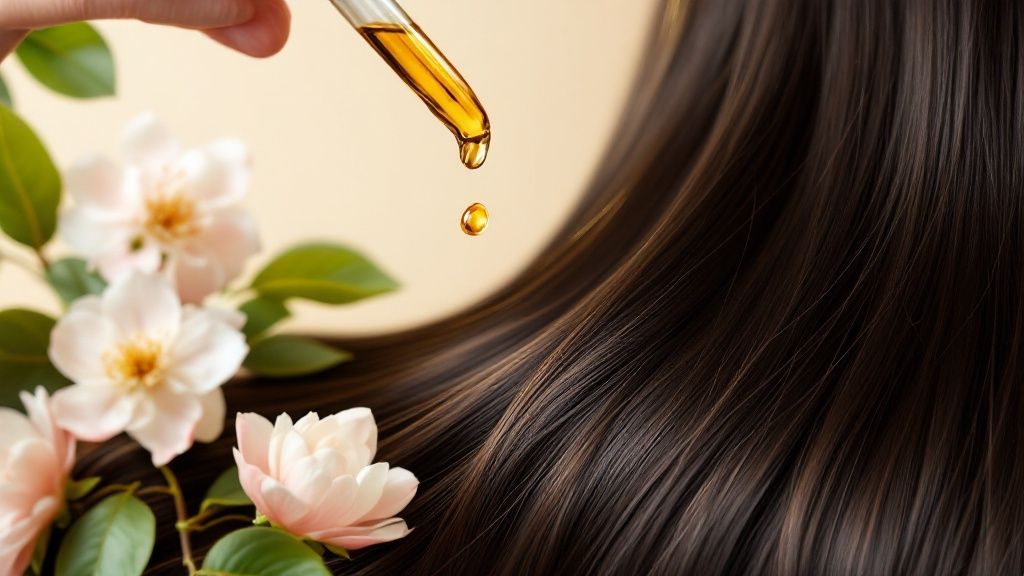
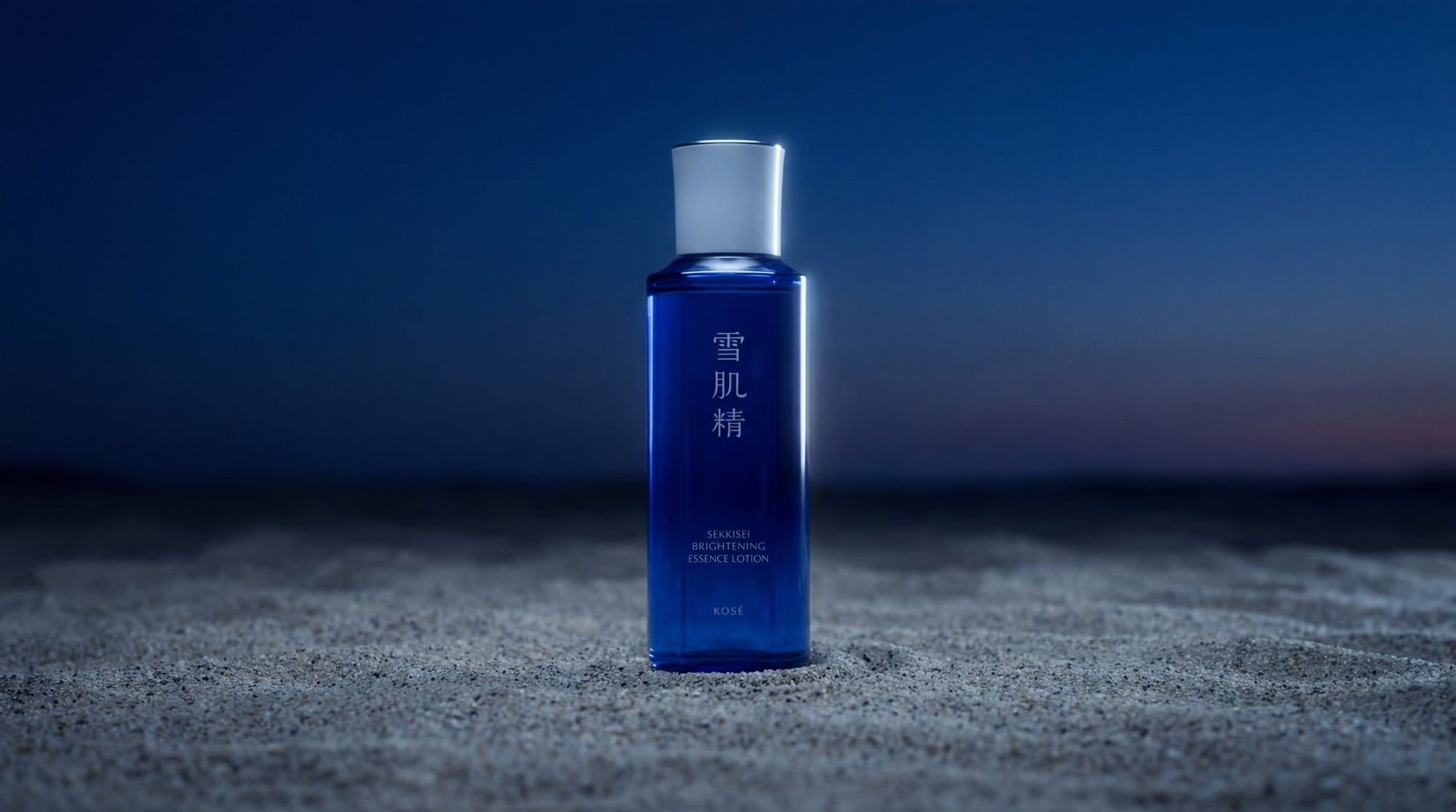


Share:
7 Best Japanese Shampoo for Hair Loss in 2025
Top Hyaluronic Acid Japan Products for Glowing Skin